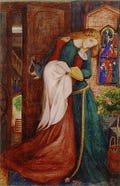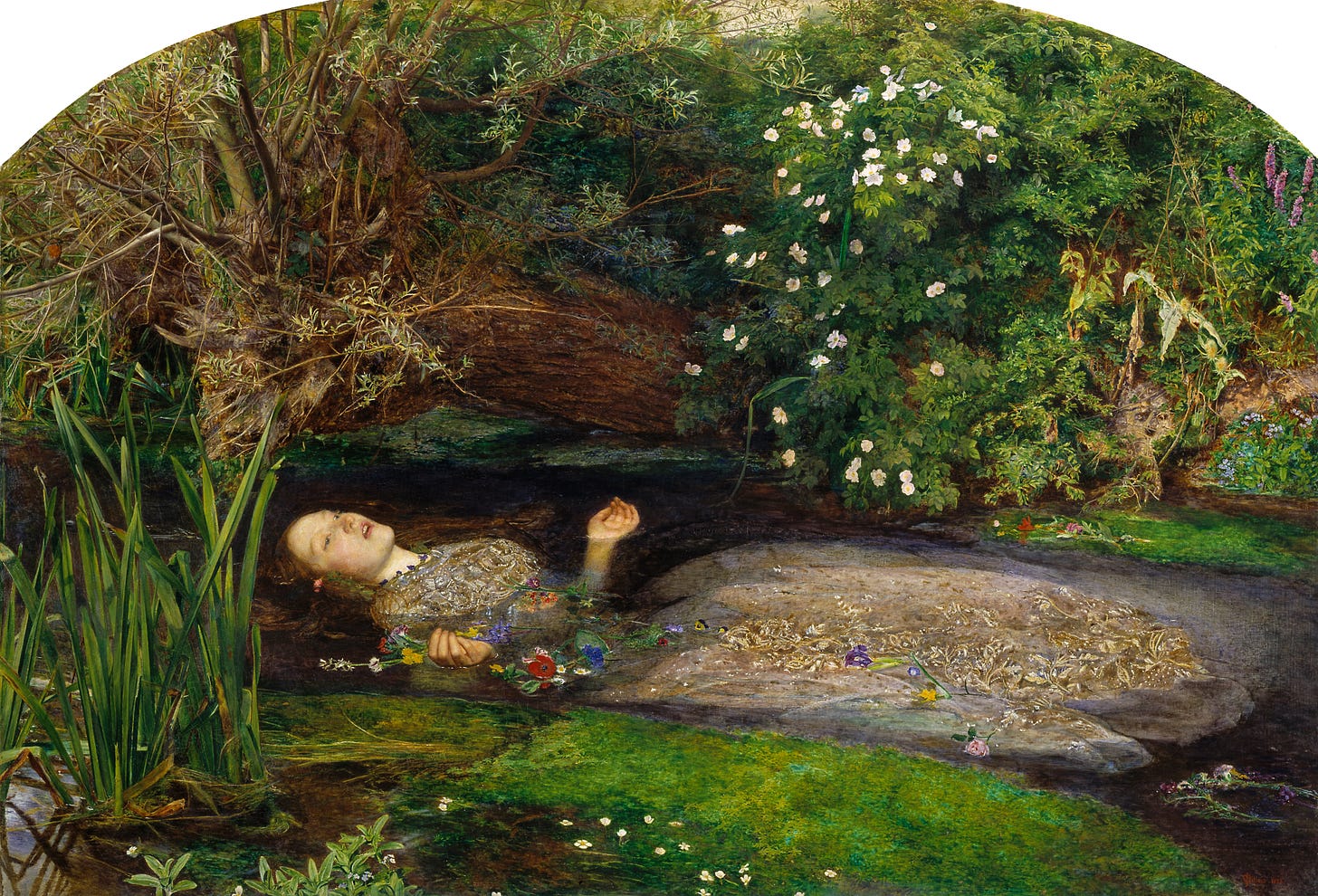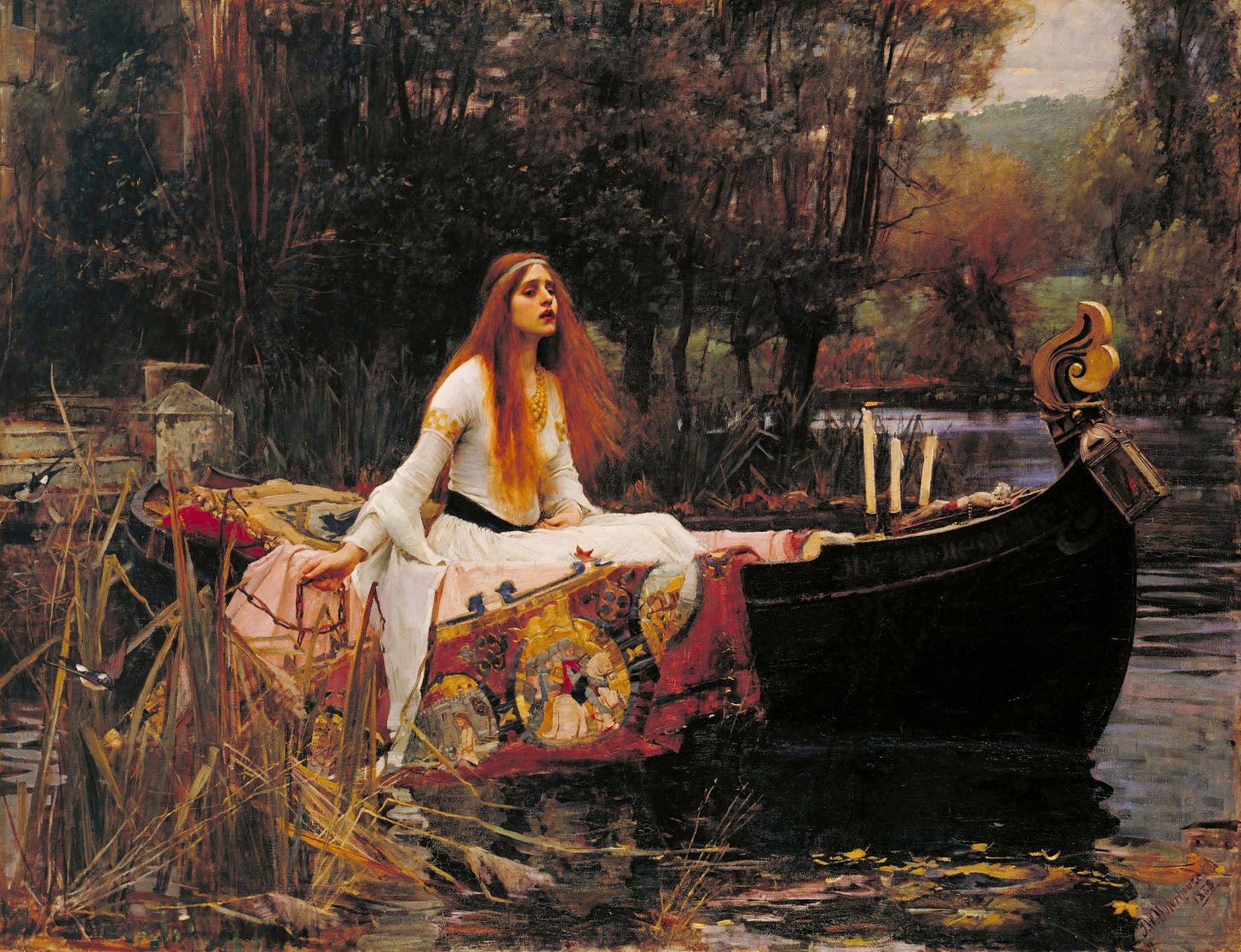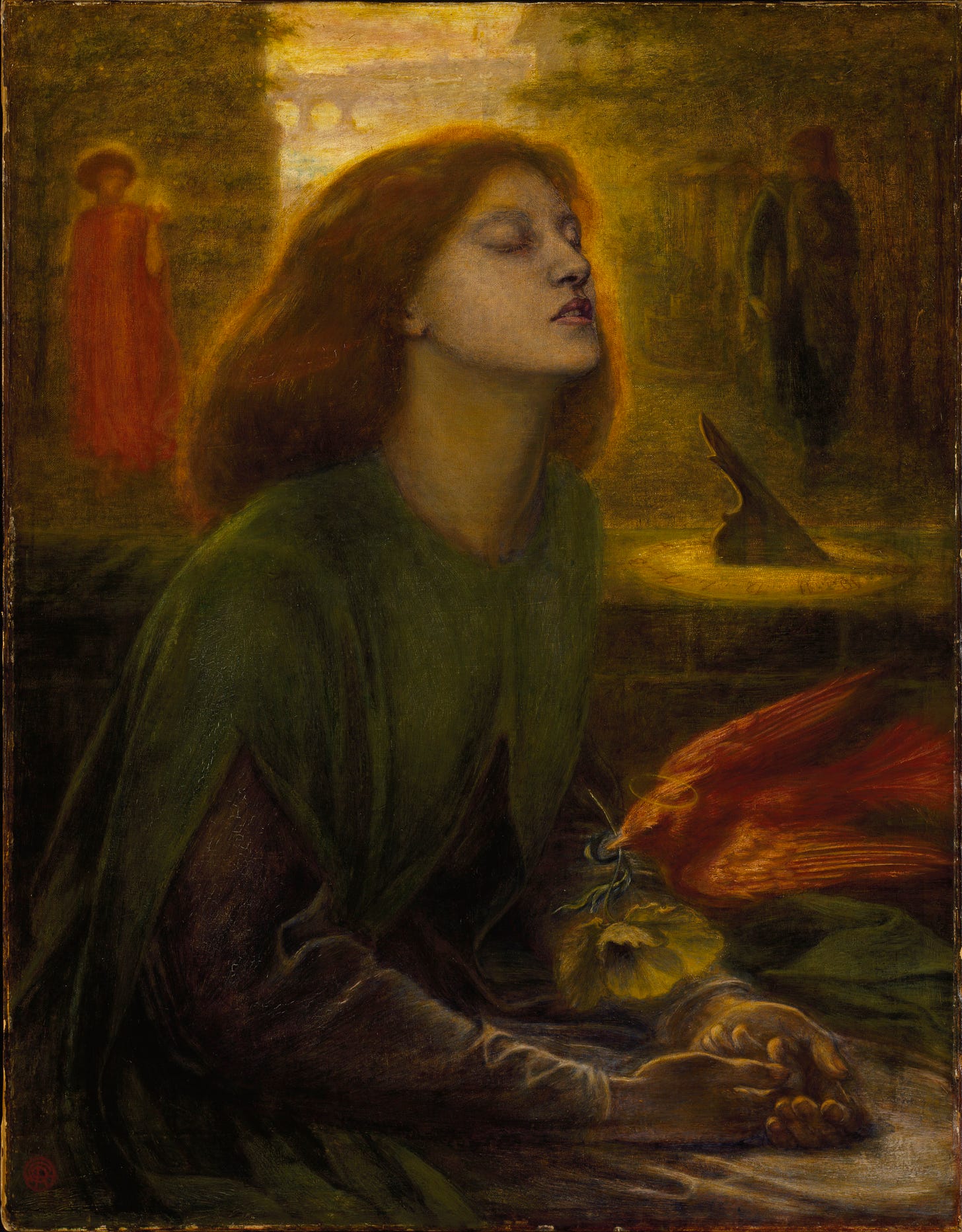Elizabeth Siddal, Lady Clare, 1857
Elizabeth Eleanor Siddal, commonly known as Lizzie Siddal, remains one of the most iconic figures of the 19th century art world. Born in 1829, she was not only a renowned model for the Pre-Raphaelite Brotherhood but also a talented artist and poet in her own right. Siddal's life was a mixture of beauty and tragedy, embodying the romantic ideals of the era while simultaneously struggling with the limitations imposed upon women in Victorian society. Her ethereal beauty, tragic love affair with Dante Gabriel Rossetti, and untimely death have all contributed to the lasting legacy of Lizzie Siddal in the annals of art history.
Born on July 25, 1829, in the Southwark district of London, she was the daughter of Charles Siddal, a cutler, and Elizabeth Eleanor Evans. The Siddal family was of modest means, and Lizzie grew up in a working-class environment. Despite the family's financial limitations, Lizzie's parents valued education and made efforts to ensure their children received some form of schooling, though Lizzie's education was likely minimal compared to middle-class standards.
From a young age, Lizzie exhibited an interest in poetry and art, though her opportunities to explore these interests were limited. Like many women of her social standing during the Victorian era, Lizzie was expected to contribute to the household income. By her late teens, she began working as a milliner's assistant in a London hat shop, a job that exposed her to the fashionable world of the city but offered little in the way of creative fulfillment.
Lizzie Siddal's life took a dramatic turn in 1849 when she was discovered by the artist Walter Deverell. While at the hat shop, Deverell was struck by Lizzie's striking beauty and distinctive red hair, which he found perfect for a painting he was working on. He persuaded her to model for him, marking the beginning of her association with the Pre-Raphaelite Brotherhood.
The Pre-Raphaelite Brotherhood, founded in 1848 by artists William Holman Hunt, John Everett Millais, and Dante Gabriel Rossetti, sought to return to the detail, intense colors, and complex compositions of Quattrocento Italian art. They rejected what they saw as the mechanistic approach that had come to dominate academic art, particularly the influence of Raphael. Lizzie's appearance, with her pale complexion, willowy figure, and auburn hair, made her the perfect muse for this new artistic movement.
Lizzie's first significant modeling work was for Deverell's painting "Twelfth Night," where she posed as Viola. This opportunity brought her into contact with other members of the Pre-Raphaelite circle, including Dante Gabriel Rossetti, with whom she would form a deep and tumultuous relationship.
John Everett Millais, Ophelia (1851–52)
Lizzie Siddal quickly became one of the most sought-after models of the Pre-Raphaelite Brotherhood. Her most famous modeling work was for John Everett Millais's painting "Ophelia" (1851-1852). In this haunting depiction of the tragic Shakespearean heroine, Lizzie posed in a bathtub filled with water to simulate Ophelia's drowning. The intense realism of the painting required Lizzie to remain in the cold water for extended periods, leading to a severe illness that would plague her for the rest of her life. Millais's "Ophelia" remains one of the most iconic images of the Pre-Raphaelite movement, and Lizzie's role in its creation is a testament to her dedication and resilience as a model.
However, it was her relationship with Dante Gabriel Rossetti that would come to define her life and legacy. Rossetti was captivated by Lizzie's beauty and began using her as a model for many of his works. Over time, their professional relationship evolved into a passionate and turbulent romance. Rossetti painted Lizzie in numerous works, often idealizing her as a figure of ethereal beauty and melancholy, reflective of his romanticized view of her.
Despite Rossetti's intense love for Lizzie, their relationship was fraught with difficulties. Rossetti was notoriously unfaithful, and his reluctance to marry Lizzie caused her considerable distress. Moreover, Lizzie's health began to deteriorate, partly due to the physical strain of modeling and the emotional turmoil of her relationship with Rossetti. She suffered from chronic illnesses, which were likely exacerbated by the laudanum she took to alleviate her pain.
Although Lizzie Siddal is most commonly remembered as a model, she was also an accomplished artist and poet. Encouraged by Rossetti, she began to pursue her own artistic endeavors, a rare opportunity for a woman of her time. Lizzie's artwork, much like that of the Pre-Raphaelite Brotherhood, was characterized by its attention to detail and its use of rich, vibrant colors.
In 1855, Lizzie exhibited a selection of her works at a Pre-Raphaelite exhibition in London. The exhibition was a critical success, and Lizzie received praise for her unique style and imaginative compositions. Her art often depicted scenes of medieval romance and tragedy, themes that resonated with the broader Pre-Raphaelite movement. Some of her notable works include "Clerk Saunders" and "The Lady of Shalott," both of which explore themes of love, loss, and the role of women in society.
In addition to her visual art, Lizzie Siddal was a talented poet. Her poetry, much like her artwork, was deeply influenced by the romantic and melancholic themes of the Pre-Raphaelites. Her poems often reflected her personal struggles, particularly her fraught relationship with Rossetti and her ongoing battle with illness. Despite the quality of her work, Lizzie's poetry was not widely published during her lifetime, though Rossetti kept many of her poems after her death, ensuring that her literary voice would not be entirely lost to history.
John William Waterhouse - The Lady of Shalott
After years of uncertainty and emotional turmoil, Lizzie Siddal and Dante Gabriel Rossetti finally married on May 23, 1860. The wedding took place in Hastings, where Lizzie was recuperating from a particularly severe illness. The marriage, however, did not bring the happiness that Lizzie had long sought. Rossetti continued his affairs with other women, and Lizzie's health remained fragile.
In 1861, Lizzie became pregnant, but the pregnancy ended in a stillbirth, a tragedy from which she never fully recovered. This loss, combined with her ongoing health issues and Rossetti's infidelities, drove Lizzie into a deep depression. She became increasingly dependent on laudanum, a common but highly addictive opiate used to treat pain and anxiety in the 19th century.
The couple's marriage, which had begun with such promise, quickly deteriorated. Rossetti, though devoted to Lizzie in his own way, struggled to cope with her declining mental and physical health. Their relationship, once a source of inspiration and passion, became mired in despair and hopelessness.
On February 11, 1862, Lizzie Siddal was found unconscious in bed by Rossetti, having overdosed on laudanum. Despite efforts to revive her, she was pronounced dead at the age of 32. The official cause of death was recorded as an accidental overdose, though many have speculated that Lizzie may have taken her own life, driven to despair by the loss of her child and the ongoing turmoil in her marriage.
Lizzie's death left Rossetti devastated. In a gesture of deep remorse and mourning, he buried a manuscript of his unpublished poems with her in Highgate Cemetery. However, in a somewhat macabre turn of events, Rossetti later had the manuscript exhumed so that he could publish the poems. This act has often been cited as emblematic of Rossetti's complex and contradictory feelings toward Lizzie—an intense love marred by selfishness and obsession.
Lizzie Siddal's legacy, however, extends far beyond her tragic death. As a muse, she played a crucial role in the development of the Pre-Raphaelite aesthetic, her image immortalized in some of the most famous works of 19th-century art. As an artist and poet, she challenged the restrictive norms of her time, carving out a space for herself in a male-dominated world. Though her life was brief and often marked by suffering, Lizzie Siddal's impact on the world of art and literature is undeniable.
Dante Gabriel Rossetti, Beata Beatrix
In the years following her death, Lizzie Siddal's life and image have continued to captivate the public imagination. She has been the subject of numerous biographies, novels, and films, each exploring different facets of her life and the complex relationship she shared with Rossetti and the other members of the Pre-Raphaelite Brotherhood.
One of the most enduring aspects of Lizzie's legacy is her representation as the quintessential Pre-Raphaelite muse—the tragic, ethereal beauty who embodies the romantic ideals of the movement. This image, while iconic, has also been criticized for overshadowing Lizzie's own artistic achievements and reducing her to a mere object of male desire.
In recent years, there has been a growing interest in reevaluating Lizzie Siddal's life and work, recognizing her not just as a muse but as a significant artist and poet in her own right. Scholars and art historians have worked to bring her artwork and poetry to the forefront, challenging the narrative that has long defined her solely in terms of her relationships with male artists.
Lizzie's story has also inspired feminist readings of the Pre-Raphaelite movement, highlighting the ways in which women like her navigated the artistic and social constraints of their time. Her life serves as a poignant reminder of the struggles faced by women in the Victorian era, particularly those who sought to break free from traditional roles and pursue their creative ambitions.
The late 20th and early 21st centuries have seen a significant rehabilitation of Lizzie Siddal's image and work. Scholars, curators, and feminist critics have increasingly focused on her as an independent artist, bringing attention to her contributions to the Pre-Raphaelite movement beyond her role as a model. Exhibitions of her work have been held, and her art has been analyzed for its unique qualities, distinct from the male artists with whom she was associated.
Lizzie's drawings and paintings, characterized by their delicate lines and haunting subject matter, reveal a deep emotional intensity and a preoccupation with themes of love, loss, and mortality. Her work often reflects her personal experiences, particularly her tumultuous relationship with Rossetti and her struggles with illness. This personal connection to her art adds a layer of poignancy to her work, offering insight into her inner world.
In addition to her visual art, Lizzie's poetry has also gained greater recognition. Her verses, which were once dismissed or overlooked, are now appreciated for their lyrical beauty and emotional depth. Lizzie's poetry often explores themes of longing, despair, and the search for meaning, reflecting the influence of Romanticism as well as her own life experiences.
The reassessment of Lizzie Siddal's work has been part of a broader movement to reexamine the contributions of women artists and writers who have been marginalized or forgotten by history. By placing Lizzie's work in the context of her life and the broader cultural and social milieu of the Victorian era, scholars have been able to provide a more nuanced understanding of her as an artist and as a woman.
Lizzie Siddal's life is a story of beauty, creativity, and tragedy. As a model, she became the face of the Pre-Raphaelite Brotherhood, her image immortalized in some of the most iconic works of 19th-century art. As an artist and poet, she challenged the limitations of her time, creating works that reflected her inner world and the struggles she faced.
Her life, though brief and often marked by suffering, continues to resonate with audiences today. Lizzie Siddal has become a symbol of the complexities of the muse-artist relationship, the challenges faced by women in the Victorian era, and the enduring power of art to capture and transcend the human experience.
Lizzie's legacy is a testament to her strength, resilience, and creative spirit. While she may have been overshadowed by the men around her during her lifetime, her story and her work have endured, ensuring that she will be remembered not just as a muse, but as an artist and poet in her own right. Through the continued study and appreciation of her work, Lizzie Siddal has finally begun to receive the recognition she deserves, not merely as a passive subject of art but as an active and significant contributor to the cultural landscape of her time.






